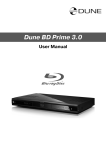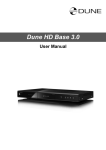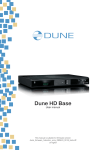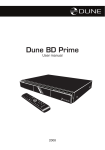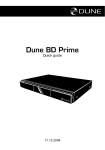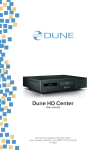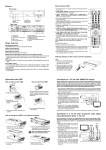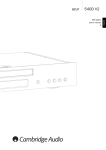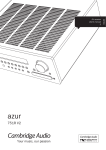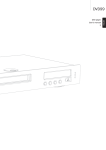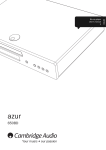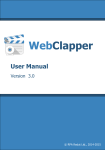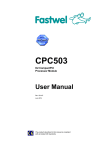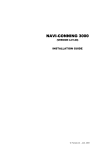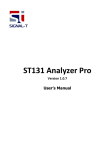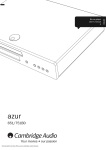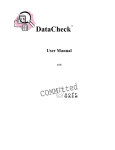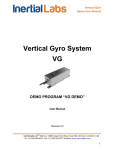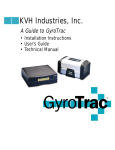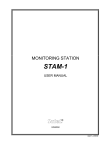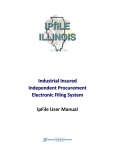Download Dune HD Base 2.0
Transcript
Dune HD Base 2.0
User Manual
Table of Contents
4 Key Features
● Player Features
● Media File Player
● Package Contents
● Copyright Notice
● Safety Measures
● Before Getting Started
● Exterior
● Installing the Internal HDD
9 Remote Control (RC)
● Entering Text with Remote Control
● Standby Mode
11 Connections
● Connecting a TV/Monitor/Projector
with HDMI/DVI Input
● Connecting a TV/Monitor/Projector with
Component (Y/Cb/Cr) Video Input
● Connecting a TV/Monitor/Projector with
Composite Video Input
● Transmission of Digital Audio to AV Receiver via HDMI Input
● Transmission of Digital Audio to AV Receiver via Optical/Coaxial Cable
● Transmission of Analog Audio to External Stereo Amplifier (or TV Set)
● Transmission of Analog 7.1 Audio to
External Amplifier (Receiver)
● Connection to LAN and Internet
● Connection of External USB Drives
16 System Setup
25 Playback
● File Browser
● Marking Files and Folders
● Copying and Moving Files and Folders
● File Playback
● Blu-ray Playback
● DVD-Video Playback
● Audio CD Playback
● Internet Radio Playback
● IPTV Playback and Recording
● HTTP Streams Playback
● Photo Viewer
36 Accessing Network Drives
● Connecting via SMB Protocol
● Connecting via NFS Protocol
● Accessing Player HDD from Network
● Connecting to the Player via FTP from a
Windows PC
● Connecting to the Player via SMB from a
Windows PC
39 Troubleshooting
● General
● Video Playback
● Network
● Reporting a Problem
43 Firmware Recovery Procedure
44 Player Specifications
45 Notes
User manual
● Setup Menu
● Quick Setting of Video Output Mode
● Setup Menu Sections
● General
● Video
● Audio
● Network
● Information
● Miscellaneous
● Menu Style
● IPTV
● Internet Radio
● Web Browser
● Torrents
● Encodings
3
Key Features
K
Chapter 1
Player Features
Media content playback
● Video (various formats), music (MP3 and others), and photos (JPEG and others).
Disc playback (when an external optical drive is connected)
● Audio CD, DVD-Video disc, Blu-ray disc (note: retail Blu-ray discs with AACS protection
are not supported).
Streaming network content
● NFS and SMB protocols (plus limited HTTP support).
HDD mobile rack with SATA DirectLink for fast and easy HDD replacement
● HDD rack allows to store media collection on any number of hard disks without the need of
expensive multi-disk NAS solutions. A standard 3.5" SATA HDD can be used, provided it has
suitable heat emission. Please see http://dune-hd.com/support/hw_compat/ for recommendations on suitable HDD models.
HDMI 1.3
● Up-to-date HDMI 1.3 interface ensures outstanding quality and compatibility of digital
video and audio signal.
Two USB 2.0 host ports
● Two high-speed USB 2.0 host ports ensure an easy-to-use playback of media content
from external data storage devices like USB HDD, flash drives, card readers, etc. USB hubs
are supported.
eSATA host port
● This high-speed port allows to plug an additional (external) HDD.
Optional extension modules
● One of the following internal modules may be installed: Wi-Fi 802.11n, Ethernet 1000
Mbps.
Dune HD Base 2.0
Media File Player
4
Media files playback is supported from the following media sources: internal SATA HDD,
external USB or eSATA HDD, USB flash drive, USB card reader, optical discs (when a USB or
eSATA optical drive is connected), network (HDD in a PC or NAS, some Internet sources).
Supported video codecs: MPEG-2, MPEG-4, DivX, Xvid, WMV 9, VC-1, H.264.
Supported video file formats: MKV, MPEG-TS, MPEG-PS, M2TS, VOB, AVI, MOV, MP4, QT,
ASF, WMV, Blu-ray-ISO, BDMV, DVD-ISO, VIDEO_TS.
For the best picture quality for viewing media files, the attached display should support
1920x1080 (1080p) or 1280x720 (720p) High Definition (HDTV) signal formats.
Package Contents
1
3
2
5
4
1. Dune HD Base 2.0 media player
2. Remote control (two AAA batteries are NOT included)
3. Power supply cord
6
4. AV cable
5. HDMI cable
6. This manual
Copyright Notice
The law prohibits copying, transmitting, displaying, broadcasting via cable network, public
playback and letting on lease of copyright-protected materials without the rightholder’s authorization. Some video discs are encoded with copy protection, and any picture recorded
from such discs will be distorted. This product incorporates a copyright protection technology which is protected by requirements of certain U.S. patents and other intellectual property rights owned by Macrovision Corporation and other rights owners. Use of this copyright
protection technology must be authorized by Macrovision Corporation and is intended for
home viewing uses. Reverse engineering or disassembly is prohibited.
Safety Measures
10cm
10cm
10cm
User manual
To Prevent Overheating
If you install your device in a closed space, it is necessary to provide enough
clearance around it for proper cooling. The clearance at each side should be
not less than 10 cm.
5
To avoid troubles, please read this manual carefully before using the device. Keep the manual for future reference.
Dune HD Base 2.0
1. In case of malfunctioning, please contact an authorized service center. There are no userserviceable parts inside the device; only a qualified engineer may attempt repairing it.
Opening the device case voids the warranty.
2. To avoid electric shock, do not touch the plugged-in player with wet hands and do not allow moisture within the case. If it happened, immediately unplug the device and contact
an authorized service center.
3. Clean the device only with a dry soft cloth. Do not use any liquid detergents or scouring
powder. In case of hard dirt, use special wipes suitable for PC cleaning. Make sure that the
wipe is dry enough (otherwise fluid drops may get inside).
4. The device is intended for indoor use only. Do not expose it to direct sunlight, do not leave
it near a heater or radiator.
5. Do not use the device in rooms with high humidity such as bathroom.
6. Do not plug in the player immediately after moving it from a cold place into a warm one;
unpack it and leave for 1.5−2 hours in order to allow evaporation of condensate on internal
parts.
7. Please make sure to switch off the player and all relevant AV equipment before connecting
them.
8. Do not place any items on top of the player. The device needs some space for proper heat
dissipation. Do not place any vessels with liquid close to the device.
9. Severe voltage surge in AC mains may result in improper operation of the device. In this
case, please unplug the player or turn it off with the POWER button on the front panel of
the player, wait for at least 15 seconds, then turn it back on. The media player will restart,
and its functionality will be restored.
10. If you intend not to use the media player for a long period of time, for safety and power
saving reasons please make sure to unplug it from the AC mains. Please be aware that in
the standby mode the player still consumes significant power
11. After turning the player completely off using the power switch or unplugging it, please
wait for at least 15 seconds before turning it on again.
6
Before Getting Started
When you start using the media player for the first time, please make sure that the shipping
package is not damaged, has no compression or opening marks.
If the package is damaged, the manufacturer shall not be held liable in respect of the
integrity of the package contents.
When you connect the media player to your AV appliances for the first time, please make
sure that all seals and retainer screws on the top enclosure are in place.
If for some reason, the seals were broken, the manufacturer shall be entitled to refuse the
free-of-charge after-sales servicing of the device (the warranty is void).
After switching on, the player performs automatic startup procedure, including boot-up of
the embedded operating system. It may take about 1 minute. After that you will get to the
Main screen (the file browser showing the root folder).
Please connect relevant AV appliances only if all devices are switched off.
Please refer to the "Connections" section below for description of the majority of connections.
Exterior
Front view
1
2
3
1. Power switch
2. Display
3. HDD rack
4
4. EJECT
5. PLAY/PAUSE
6. STOP
5
6
7
8
9
7. PREV
8. NEXT
9. USB 2.0 host
Rear view
HD BASE 2.0
POWER SUPPLY: AC~ 100V-240V, 50/60Hz, 27W
In collaboration of HDI,
China Hualu Group
Made in China
eSATA
/USB
1
COMPOSITE
VIDEO OUT
2
3
4
5
6
7
8
10
6. Component (Y/Pb/Pr) video output
7. Composite video output
8. eSATA host
9. Multichannel (7.1) analog audio output
10. AC power
User manual
1. 100 Mbps LAN and USB 2.0 host
2. HDMI 1.3
3. Coaxial digital audio output
4. Optical digital audio output
5. Analog stereo (left/right) audio
output
9
7
Installing the Internal HDD
1. Push the cover at the right.
3. Pull the handle.
2. Open the cover.
4. Open the door.
Dune HD Base 2.0
HDD
8
5. Insert an HDD.
6. Close the door.
Completely power off the player (using the front panel power switch)
before removing or installing the internal HDD. Switching the player to
the Standby mode using the RC is not enough.
Remote Control (RC)
Chapter 2
1. Command indicator — flashes in response to RC button pressing.
1
2. EJECT — open/close the optical drive tray (if the external optical
2
drive is connected). MUTE — turn the sound on/off. MODE — switch
the video mode; control some other player functions. POWER — tog- 3
gle the standby mode.
3. A (Red), B (Green), C (Yellow), D (Blue) — access Blu-ray disc features; control some other player functions.
4
4. 0–9 — enter numbers and text; control some other player functions.
5
5. SEARCH — jump to a specified playback position. ZOOM —
6
change the zoom factor for the video content being played.
7
6. V+/V– (volume up / volume down) — adjust the volume.
P+/P– (page up / page down) — scroll up and down in various lists;
8
control some other player functions.
7. SETUP — enter/leave the main Setup menu; adjust playback settings during playback.
8. Arrows (LEFT, RIGHT, DOWN, UP), ENTER, RETURN, TOP
9
MENU, POP UP MENU, INFO — main buttons for controlling the player (navigate across the items on the screen, open/use the currently selected item, go back to the previous screen, go to main menu, show 10
popup menu with actions, show information, control some other player
functions).
9. PLAY, PAUSE, STOP, SLOW, REW, FWD, PREV, NEXT — control the playback.
10. SUBTITLE, URL/2nd audio, ANGLE/ROTATE, REPEAT, SHUFFLE/PIP, AUDIO — control the playback and some other player functions.
Some RC buttons may have several functions depending on the current player mode. Some
RC buttons may be available only in certain player modes or only during playback of a certain
content.
User manual
Notes:
● Use alkaline AAA batteries.
● Observe polarity when inserting batteries.
● Direct the remote control to the player. There must be no obstacles between the RC and
the player. If the player is installed behind a tinted glass, the manufacturer may not guarantee an undisturbed functioning of RC.
● If RC functions only at short distances or stopps functioning, make sure to replace the
batteries.
9
Entering Text with Remote Control
Generally, entering text is carried out the same way as with most cell
phones.
0, 1, 2, 3, 4, 5, 6, 7, 8, 9: Enter a character to the position pointed
by the cursor.
First press: enter the first character from a set of characters related
to this button. Each subsequent press: you may change the entered
character to the next one from this set.
● 0: enter the space.
● 1: enter a special character (punctuation marks, etc).
● Up, Down, Left, Right after pressing 1 (special character entering
mode): select the required character.
ENTER — confirm selection; finish text entering.
SUBTITLE — enter the period (for numeric mode); functions like button 1 (character mode).
CLEAR (<-) — delete a character to the left of cursor.
SELECT (cap|num) — switch input mode:
abc: character mode, small latin letters.
abc
ABC: character mode, capital latin letters.
123: numeric mode, digits.
RETURN — cancel the text changes and finish text entering.
Left/Right — move the cursor one character left/right.
Up/Down — move the cursor to the start/end of a text line.
● If the cursor is already in start/end position: select another user interface element which is
under/over the current text entry area (only for dialogs with several elements of user interface; text changes are confirmed automatically).
POP UP MENU — show context menu with a list of available commands. They allow you
to cut, copy and paste text using the clipboard, much like it is done on a PC.
Dune HD Base 2.0
Standby Mode
Pressing the POWER remote control button switches the player to the Standby mode.
In this mode the built-in HDD is turned off, as well as the video output, but the device
does not switch off completely.
To activate the player from the Standby mode, press the POWER remote control button once
again. The player will be switched on immediately (within several seconds).
Note: you can also configure the player to power off completely when pressing the POWER
remote control button (see Setup / Miscellaneous / Advanced / "POWER" remote button).
10
Connections
Chapter 3
This chapter describes different possibilities of connecting the media player to AV
equipment.
Depending on the model and the design of a TV/monitor/projector, after connecting it using one
of the provided schemes and plugging in the power, the player initialization may take up to 10
sec. If after this time there is no picture (a "DUNE" logo) on the screen, then it is a problem with
the cable connection or the TV/monitor/projector. Please check the "Troubleshooting" section
in such case.
If, after the initial screen (a "DUNE" logo) disappears, there is no other picture on the screen in 10
sec and more, then it is most likely a problem of incorrect video mode set in the player. Please address the "Quick Setting of Video Output Mode" section below in such case.
Connecting a TV/Monitor/Projector with
HDMI/DVI Input
HD BASE 2.0
In collaboration of HDI,
China Hualu Group
Made in China
eSATA
/USB
COMPOSITE
VIDEO OUT
HDMI IN
Since the player is designed first of all for playback of high definition (HD) video (up to 1080p),
the best way of signal transmission from the player to a TV/monitor/projector is the HDMI interface. In this case, video and audio streams are transmitted in digital form, without loss, delivering excellent picture and sound.
If your TV/monitor/projector has no HDMI port but is equipped with the DVI one, you can
use an HDMI-DVI adapter (to be connected to HDMI-HDMI cable) or HDMI-DVI cable (no
adapter needed). In this case, transmission of audio stream via HDMI is not supported, so
one of the analog or digital audio outputs has to be used.
User manual
1. Make sure that the player and the TV/monitor/projector is switched off. Do not switch them
on until the connection procedure is finished.
2. Connect the HDMI/DVI cable and (if needed) the HDMI-DVI adapter.
3. Using RC/buttons of the TV/monitor/projector, select the required input port and (for display
mode. For further instructions please refer to the manual of your displaying equipment.
4. Power on the devices. Wait until the initial screen (a "Dune" logo) is shown.
11
Connecting a TV/Monitor/Projector with Component
(Y/Cb/Cr) Video Input
For this connection you should use a
COMPONENT
VIDEO IN
3RCA-3RCA video cable and (optionally) a
AUDIO IN
2RCA-2RCA audio cable for sound transR
L
mission to your TV set. Please note that
video cable shall have an impedance of 75
Ohm, i.e. specially designed for transmission of analog video signal.
1. Make sure that the player and the displaying device are switched off. Do not
switch them on until the connection
procedure is finished.
2. Connect the component video output
of the media player to the relevant TV/
monitor/projector input using a 3RCA3RCA cable.
3. Optionally connect the analog stereo audio output (AUDIO L/R) of the player to the relevant
input of a TV/monitor/projector using a 2RCA-2RCA cable. Instead, you can use optical
cable to transmit digital audio to your AV receiver; in this case better audio quality may be
expected.
4. Using RC/buttons of TV/monitor/projector, select the required input and display mode. For
further instructions please refer to the manual of your displaying equipment.
5. Power on the devices. Wait until the initial screen (a "Dune" logo) is shown.
HD BASE 2.0
In collaboration of HDI,
China Hualu Group
Made in China
eSATA
/USB
COMPOSITE
VIDEO OUT
Connecting a TV/Monitor/Projector with Composite Video Input
AUDIO IN
Since this kind of connection does not
L
R
provide a high-quality picture, we recommend to use it only in case your TV/
monitor/projector does not have High
Definition video interfaces, such as
HDMI, DVI or Component (Y/Cb/Cr).
1. Make sure that the player the TV/
monitor/projector are switched off. Do
not switch them on until the connection procedure is finished.
2. Connect the media player to the relevant TV/monitor/projector input using an RCA-RCA cable.
3. Optionally connect the analog stereo audio output (AUDIO L/R) of the player to the relevant
input of the TV/monitor/projector using a 2RCA-2RCA cable. Instead, you can use optical
cable to transmit digital audio to your AV receiver; in this case better audio quality may be
expected.
4. Using the RC/buttons of your TV/monitor/projector, select the required input and display
mode. For further instructions please refer to the manual of your displaying equipment.
HD BASE 2.0
In collaboration of HDI,
China Hualu Group
Made in China
eSATA
Dune HD Base 2.0
/USB
12
COMPOSITE
VIDEO OUT
Transmission of Digital Audio to AV Receiver via
HDMI Input
This media player is equipped with an up-to-date HDMI 1.3 interface, allowing transmission of digital video and audio streams via a single cable. If your AV receiver has
an HDMI 1.3 input and decoders for up-to-date audio formats, you may fully enjoy
an HD multichannel sound.
1. Make sure that the player and the AV receiver are switched off. Do not switch them on until
the connection procedure is finished.
2. Connect the HDMI output of the media player to the HDMI input of your AV receiver using
an HDMI-HDMI cable.
3. Using the RC/buttons of the AV receiver, select an appropriate mode (refer to your AV
receiver manual).
HD BASE 2.0
In collaboration of HDI,
China Hualu Group
Made in China
eSATA
/USB
COMPOSITE
VIDEO OUT
HDMI IN
We recommend you to turn down the volume of your audio equipment before connection,
in order to protect your hearing from unexpectedly high volume, and to eliminate the risk
of damage to your audio system.
Transmission of Digital Audio to AV Receiver via
Optical/Coaxial Cable
An optical Toslink–Toslink or coaxial (75 Ohm) audio cable shall be used (not included).
1. Connect digital audio output of the player to the digital audio input of the AV receiver.
2. Select relevant input and sound mode on the AV receiver.
HD BASE 2.0
In collaboration of HDI,
China Hualu Group
Made in China
/USB
We recommend you to turn down the volume of your audio equipment before connection, in order to protect your hearing from unexpectedly high volume, and to eliminate
the risk of damage to your audio system.
User manual
Optical
13
Transmission of Analog Audio to External Stereo
Amplifier (or TV Set)
An analog 2RCA-2RCA cable shall be used (not included).
1. Connect analog stereo audio output (AUDIO L/R) of your player to the audio input of your stereo amplifier.
2. Select a relevant input in your amplifier.
We recommend you to turn down the volume of your audio equipment before connection, in order to protect your hearing from unexpectedly high volume, and to eliminate
the risk of damage to your audio system.
You may send the analog audio
signal from your player to the TV
AUDIO IN
set, in case you use DVI, ComL
R
ponent video, or Composite video for video signal transmission
and don’t use an AV receiver for
digital audio decoding. In case of
connection via HDMI, video and
audio signals will be transmitted
using a single HDMI cable, that’s
why there is no need of additional analog audio connections in
this case.
HD BASE 2.0
In collaboration of HDI,
China Hualu Group
Made in China
eSATA
/USB
COMPOSITE
VIDEO OUT
Dune HD Base 2.0
Transmission of Analog 7.1 Audio to External Amplifier (Receiver)
14
eSATA
COMPOSITE
VIDEO OUT
Four analog 2RCA-2RCA
cables shall be used (not included). It is better to use
four identical cables.
We recommend you to turn
down the volume of your audio
equipment before connection, in order to protect your
hearing from unexpectedly
high volume, and to eliminate
the risk of damage to your audio system.
Connection to LAN and Internet
A standard Cat.5, Cat.5e or Cat.6 Ethernet cable with RJ-45 connectors should be
used (not included).
HD BASE 2.0
In collaboration of HDI,
China Hualu Group
Made in China
/USB
Connection of External USB Drives
Your media player is equipped with USB ports for connection of external data storage devices with USB interface. There are two standard A-type USB 2.0 host ports.
HD BASE 2.0
In collaboration of HDI,
China Hualu Group
Made in China
eSATA
/USB
COMPOSITE
VIDEO OUT
1. Connect a USB cable of external device to your media player.
2. Wait until the file browser shows a new corresponding icon in the root folder; this indicates
that the connected equipment is initialized.
User manual
Playback and other operations with USB drives are described in the "Playback" section
below.
15
System Setup
Chapter 4
This chapter describes a list of settings of different functions of your media player.
Setup Menu
● The setup menu may be entered only from the file browser mode.
WARNING: During media files playback, an access to the setup menu is disabled. In order to enter the menu you need to stop the playback first.
● To enter the setup menu, press SETUP on your RC or enter the Setup folder in the Main
screen of the player (the file browser showing the root folder).
● To exit the setup menu, press SETUP once again, or press the RETURN button.
● To browse the setup menu, use RC buttons Up, Down, RETURN/Left, ENTER/Right.
Dune HD Base 2.0
Quick Setting of Video Output Mode
16
The MODE button of the RC allows quick setting of video output mode without entering the setup menu. This type of video output configuration may be
required in case after connecting your player to a TV/monitor/projector you
see no picture on the screen.
After pressing the MODE button you will enter the quick video setting mode.
In this mode, pressing one of the digit buttons 1, 2, 3, 4, 5 switches to one
of the following video output modes respectively:
1. Composite/Component, PAL
2. Composite/Component, NTSC
3. HDMI, 480i, 60 Hz
4. HDMI, 720p, 60 Hz
5. HDMI, 1080i, 60 Hz
To exit the quick video setting mode after successful settings, press ENTER
on your RC.
● After pressing the MODE and a digit button please wait for up to 15 sec.
before the new video mode is settled.
● The 5 listed video modes are provided only to ensure that you can quickly
set up some usable video mode for any type of video connection you are
using, regardless the previous settings of your player.
● After getting a picture on the screen with one of these modes, please go
to Setup menu and choose the most appropriate video output and resolution.
● During a video playback, the MODE button is deactivated. To change parameters of video output, stop playback by pressing the STOP button.
In case of any problems, to make sure that the playback is stopped and you
are in the file browser mode, switch the player off and then on, and wait until
the player boots completely for up to 60 sec. Refer to the "Standby Mode"
section.
Setup Menu Sections
General
This section descrbes selection of general interface language and timeout for the
screen saver activation.
User manual
17
Video
Dune HD Base 2.0
In this section you will find settings of video output type (digital HDMI or analog) and
adjusting of video resolution on selected output.
● The selected resolution will be used by default for all media files.
● Read carefully the manual for your TV/monitor/projector. Some video modes may not be
supported by your equipment.
● In case of using the HDMI connection, depending on HDMI support in your TV/monitor/
projector, intermediate HDMI equipment (if any) and the player, some video modes may
not be available or may function improperly. In this case, use other video modes or other
connection type.
● To have the best picture quality, it is recommended to use an HDMI connection. Refer to
the "Connection to TV/Monitor/Projector via HDMI Input" section.
18
Audio
This section of the setup menu allows to set the connection type of relevant audio
equipment.
Digital audio output mode: you may switch the mode of digital optical output.
Original (Bitstream): a mode in which the original sound track, i.e. Dolby Digital or DTS, is
transmitted to an external decoder in its original, encoded, form. Refer to the "Transmission
of Digital Audio to AV Receiver" section.
User manual
PCM (Pulse Code Modulation, forced decoding): a mode in which the original sound
track, i.e. Dolby Digital or DTS, is converted (decoded) to the Pulse Code form. It is supported by decoders of virtually any up-to-date audio equipment. But this mode is only recommended in case your AV receiver does not support full decoding of multichannel sound of
above formats, or the audio subsystem of a TV set connected via HDMI cable is used instead
of a home theater system.
19
HDMI audio: turn on and off transmition of audio signal via HDMI
Blu-ray audio
● When set to "Best quality", and the "Digital audio output mode" set to "Bitstream", the primary audio track is sent to both S/PDIF (digital audio output) and HDMI as a bitstream
not depending on the presence of secondary audiotrack; secondary audio/video functions
("PiP") are disabled.
● When set to "PiP support", secondary audio/video functions are enabled, and, to support
these functions, the player is allowed to use the "decode" mode instead of the "bitstream"
mode on digital audio outputs (so the audio quality may suffer, e.g. stereo PCM may be sent
to the S/PDIF output, and multichannel PCM may be sent to the HDMI output).
Network
Dune HD Base 2.0
This section describes main parameters of connecting the media player to a LAN or
Internet.
Connection. You may select a type of connection which will be used by default. It may be
Wired (twisted-pair cable connection) or Wireless (Wi-Fi connection; optional). Alternatively,
the connection may be disabled at all.
20
Selection of networking mode:
Auto (DHCP): The media player is instructed to automatically receive an IP address and
other parameters required for TCP/IP network.
Manually: All TCP/IP parameters are set by the user.
Information
This section provides system information about your device.
User manual
21
Miscellaneous
This section offers additional settings of your media player.
Menu Style
Dune HD Base 2.0
This section allows to select a visual style of the player menu.
You may use the menu style that is most suitable for you. It may be icons, or text messages.
22
IPTV
This section describes media player setting for reception of IPTV channels.
In this Setup section, you may choose whether to show the IPTV feature on the main menu
(the file browser root folder).
● For detailed instructions on using and setting up the IPTV, please refer to
http://dune-hd.com/support/iptv/
Internet Radio
This section describes media player setting for reception of Internet radio stations.
In this Setup section, you may choose whether to show the IPTV feature on the main menu
(the file browser root folder).
● For detailed instructions on using and setting up the IPTV, please refer to
http://dune-hd.com/support/inet_radio/
User manual
23
Web Browser
This section describes media player setting for web browsing.
In this Setup section, you may choose whether to show the web browser item on the main
menu (the file browser root folder).
● For detailed instructions on using and setting up the Web Browser, please refer to
http://dune-hd.com/support/web_browser/
Torrents
This section describes media player setting for torrent downloading.
In this Setup section, you may configure the built-in torrent client.
● For detailed instructions on using and setting up the torrent client, please refer to
http://dune-hd.com/support/torrent_client/
Encodings
Dune HD Base 2.0
This section allows to select text encoding for various player features.
24
Playback
Chapter 5
File Browser
The file browser allows browsing of all files and folders available. Browsing starts from the
Main screen (also called the root folder), which includes subdivisions corresponding to
connected drives and network resources.
Up: Select the previous file/folder from the list. Move the cursor to the area of the current path indication
(in case the selection is on the first element of the list).
Down: Select the next file/folder from the list.
Left/Right: Depending on the chosen menu style, navigate the icon grid or perform the same function
as the ENTER/RETURN buttons respectively.
P+: Select a file from the top of the page / move one page up.
P–: Select a file from the bottom of the page / move one page down.
RETURN: Return to the main (root) folder.
ENTER:
Start playback of the selected media file.
Show the selected picture.
User manual
Enter the folder (when selected).
Start playback of DVD-Video folder or Blu-ray folder.
Start firmware update (in case a firmware file is selected).
25
PLAY:
Start playing of all media files in the current folder (except for the files in subfolders) starting from the
current file (you need to select a starting file using arrow buttons).
Dune HD Base 2.0
Start playback of DVD-Video folder or Blu-ray folder.
Start playback of all files in the selected folder, including files in subfolders, in alphabetical
order.
Start playback of all marked files (in the same order as displayed).
MENU: Show context menu with a list of available additional commands for the selected
file/folder and the current folder. Using the context menu allows you to execute the following commands:
● Display information on the selected file/folder (also allows to test file reading speed).
● Open a DVD-Video structure (browse disc contents instead of starting the playback).
● Mark or unmark the selected file/folder.
● Mark or unmark all files/folders in the current folder.
● Delete marked file(s)/folder(s).
● Copy marked file(s)/folder(s) (files/folders names are put to the clipboard).
● Cut marked file(s)/folder(s) (files/folders names are put to the clipboard).
● Paste previously copied/cut files/folders from the clipboard to the current folder (i.e. perform copying/moving of files/folders).
● Refresh the current folder contents.
● Create a folder.
● Create a network folder (only on Main screen).
● Change network folder definition.
● Delete network folder.
SELECT: Mark or unmark the selected file/folder, then move the selection to the next file/
folder in the list.
CLEAR (<-): Delete the selected file/folder or marked files/folders
(a confirmation is requested).
INFO: Display information on files/folders or the selected drive (also allows
to test the file reading speed).
ANGLE/ROTATE: Refresh the contents of the current folder.
REPEAT: Return to the Main screen (the root folder) of the file browser.
SETUP: Switch to the Setup menu.
MODE: Switch to the quick setting of video output mode.
A (Red): (being pressed three times sequentially): Generate a debug dump in the current
folder.
26
Marking Files and Folders
To execute operations with several files/folders at the same time, you may mark these
files/folders. Use SELECT button on your RC or commands of the context menu.
You may mark files/folders only within the current folder. In case of switching to another
folder, the information on marks will be reset.
Copying and Moving Files and Folders
● Copying and moving files/folders is performed using the clipboard, much like it is done
on a PC.
● To copy files/folders you need first to copy them to the clipboard, then go to the target
folder and perform the Paste action.
● To move files/folders, you should first cut them to the clipboard, then go to the target folder
and perform the Paste action.
● Cut, Copy and Paste actions may be executed using the context menu.
● In case of copying or moving a folder, its content will be copied/moved entirely, including
all subfolders and their contents.
User manual
27
● To copy or move several files/folders at once, you should mark these files/folders.
In case of moving files/folders within a single partition of a drive, there is no physical copying of the data (only the directory information is updated on the drive), files/folders are
moved to the new location instantly. In case of moving files/folders between different partitions or different drives, files/folders will be first copied to the new location, and then deleted from the old location. During copying you should not unplug the player or disconnect
the drive. Otherwise the information loss may occur.
Dune HD Base 2.0
File Playback
28
The player supports playback of media files (video, music, photos) in various formats. You
can play files from any drives attached to the player, or from network drives.
To play a media file, select the file in the file browser, and press ENTER.
To play all media files in the current folder starting with a certain file, select the file in the file
browser, and press PLAY. The player will generate a playlist consisting of all media files in the
current folder (not including files in subfolders), and will start playback of this playlist starting
with the selected file.
To play all media files in a certain folder (including files in subfolders), select the folder,
and press PLAY. The player will generate a playlist consisting of all media files in the folder
(including files in all subfolders), and will start playback of this playlist.
To play a predefined playlist file (in M3U or PLS format), select the playlist file, and press
PLAY. The player will load the playlist file, and will start playback of all items in the loaded
playlist.
To play a given set of media files and/or folders and/or playlist files, mark all needed files
and/or folders and/or playlist files using RC buttons SELECT and MENU, and press PLAY.
The player will generate a playlist comprising all marked content (including all marked media
files, all media files in the marked folders and all their subfolders, and all items from the
marked playlist files), and will start playback of this playlist.
During playback of a playlist, you can easily navigate through the playlist using RC buttons
NEXT, PREV, MENU.
When playing video or audio files, the player uses so called "file playback mode". Entering
and leaving the file playback mode may take some time, and black screen may be shown.
When playing a list of photos, a special photo viewer application is used for nice photo
showing with transition effects (see "Photo Viewer" section). When starting playback of a
list of media files consisting of both photos and other kinds of media files (video, audio), the
player will ask whether you want to show photos or play video and audio files.
In file playback mode, the following RC buttons are available:
STOP: Finish playback, return to the file browser.
PAUSE (||): First press: switch to the pause mode.
● Subsequent presses: frame-by-frame display (switch to the next frame).
● To exit the pause mode, press PLAY.
Left/Right/Up/Down/P+/P–: First press: switch to playback position changing mode.
● Subsequent presses: change the playback position:
● Left/Right: Backward/forward by 10 sec.
● Up/Down: Backward/forward by 1 min.
● P+/P–: Backward/forward by 10 min.
● To exit the playback position changing mode, press the ENTER button (or wait until automatic switching to the selected position occurs after a short period of time).
0, 1, 2, 3, 4, 5, 6, 7, 8, 9: Switch playback position to 0%, 10%, 20%, 30%, 40%, 50%,
60%, 70%, 80%, 90% (from the beginning of the file).
FWD (>>), REW (<<): Switch to the accelerated forward/backward playback, increase frame
rate (switch between acceleration modes 1x, 2x, 4x, 8x, 16x, 32x).
● To return to the normal playback, press PLAY.
SLOW (|>): Switch to the slow-motion forward playback, decrease frame rate (switch between
1x, 1/2x, 1/4x, 1/8x, 1/16x, 1/32x).
● To return to normal playback, press PLAY.
INFO: Show/hide information on the current file:
File name. Container type. Format (codec type). Resolution of the video stream in the file.
Maximum bitrate (statistics of the current session of file playback). Average bitrate (statistics
of the current session of file playback). Current bitrate (playback statistics). Duration.
AUDIO: First press: display information on the current sound track.
● Subsequent presses: switch to the next sound track.
SUBTITLE: First press: display information on the current subtitles.
● Subsequent presses: switch to the next subtitles.
● Up/Down: Move subtitles up/down.
● Subsequent presses: switch to subsequent picture zooming mode.
● In case the Special zooming mode is selected, the following RC buttons are enabled:
User manual
ZOOM: First press: switch to picture zooming mode, display information on current zoom
setting.
● Left/Right: Zoom in/out (proportional picture stretching).
● Up/Down: Increase/decrease vertical stretching (proportions adjusting).
29
● P+/P–: Increase/decrease the overscan area (useful to compensate for picture cropping by a TV/projector).
● To exit the picture zooming mode, press ENTER or wait until
automatic exit will be performed after a short period of time.
SETUP: Display picture parameters setup menu (contrast,
brightness, hue, saturation).
● Up/Down: Select previous/next parameter.
● Left/Right: Decrease/increase the current parameter value.
● CLEAR: Reset to the default value.
● To exit the picture parameter setting mode, press ENTER (or wait
until automatic exit occurs after a short period of time).
MODE: Switch the deinterlacing mode used for playback of interlaced content. Modes available: motion adaptive (default), bob,
constant blend, disabled.
A (Red): Switch to the sound synchronization adjustment mode,
display information on current setting.
● Left: decrease adjustment value ("move" the sound backwards
in time relatively to the video).
● Right: increase adjustment value ("move" the sound forward in
time relatively to video).
● To exit the adjustment mode, press ENTER or wait until automatic
exit occurs after a short period of time.
B (Green): First press: display information on the current status of
video frame rate adjustment.
● Subsequent presses: turn on/off video frame rate adjustment. In
case of activated adjustment, the video frame rate increases by a
factor of 25/23.976.
PREV (|<<): Start playback of the current file from the beginning
or switch to the previous file from the playlist (if the current playback
position is close to the file beginning).
NEXT (>>|): Switch to the next file from the playlist.
MENU: Toggle showing of the browser of the current playlist.
● The browser displays the current playlist and the current item
played.
● Up/Down/P+/P–: Navigate in the playlist.
Dune HD Base 2.0
● ENTER: Switch to the selected item in the playlist.
30
● REPEAT: Toggle the cyclic playback of the playlist.
● SHUFFLE: Toggle the random playback of the playlist.
Blu-ray Playback
The player supports playback of Blu-ray discs (when a Blu-drive is connected to the player)
and Blu-ray images (ISO files and BDMV folders). When you play a Blu-ray disc or image, the
player uses so called "Blu-ray playback mode". In the Blu-ray playback mode, Blu-ray features such as Blu-ray menu, Blu-ray subtitles, BD-J, Bonus View, BD Live, are supported.
Note: when playing a Blu-ray disc or image, make sure that the System Storage USB flash
drive is attached to the player and is recognized by the player (because it may be required for
playback of the Blu-ray disc or image). Check Setup / System Information / System Storage
to see whether the System Storage is attached. For more information on the System Storage,
please see http://dune-hd.com/support/usb_flash_drive/.
Note: only Blu-ray discs without AACS protection are supported. Retail Blu-ray discs with
AACS protection are not supported.
To play a Blu-ray disc, navigate to the Main screen of the file browser, and insert the disc into
a Blu-ray drive attached to the player. The player will recognize the inserted Blu-ray disc and
highlight the corresponding optical drive item on the Main screen. Select this optical drive
item and press ENTER or PLAY. The player will start loading the Blu-ray disc.
To play a Blu-ray image, select the corresponding ISO file or Blu-ray folder (a folder containing "BDMV" subfolder), and press ENTER or PLAY. The player will start loading the Blu-ray
image.
Depending on a particular Blu-ray disc or image, its loading may take some time (up to several minutes). While a Blu-ray disc or image is being loading, you may see a blank screen or
"loading..." or a similar message on the screen. After the Blu-ray disc or image is loaded, the
player will start playback of the disc (e.g. will show the disc menu).
In Blu-ray playback mode, the following RC buttons are available:
Left/Right/Up/Down/ENTER/RETURN: Navigate the disc menu.
POP UP MENU: Display an interactive menu of the disc (selection of scenes, switching between titles, additional materials, etc).
TOP MENU: Switch to the top menu of the disc.
A (Red), B (Green), C (Yellow), D (Blue): Perform functions specific to a particular Blu-ray disc.
STOP: Finish the playback, return to the Main screen of the file browser.
PAUSE: First press: switch to the pause mode.
● Subsequent presses: frame-by-frame playback (switching to the next frame).
● PLAY: Continue the playback.
SEARCH: Go directly to the desired time position.
PREV (|<<): Start playing back the current chapter from the beginning or switch to playback
of the previous chapter.
NEXT (|>>): Move to playback of the next chapter on the disc.
● PLAY: Return to the normal playback.
SLOW (|>): Switch to the slow-motion playback. Switching between modes: 1x, 1/2x, 1/4x,
1/8x.
User manual
FWD (>>), REW (<<): Switch to accelerated forward/backward playback mode, switching
between acceleration modes: 1x, 2x, 4x, 16x.
● PLAY: Return to the normal playback.
31
INFO: Show information on current status of the player:
● Current operation: PLAY, PAUSE, etc.
● Type of optical media used currently: BD-ROM, BD-R, etc.
● Type of sound track: Stream type DD, DD+, DTS, etc.
● Type of content and current playback time, e.g. "HDMV 00:25:53".
● Current disc title, e.g. "Title 1/11".
● Current disc chapter, e.g. "Chapter 8/27".
● Current bitrate, e.g. "Bitrate 34.43 Mbps".
AUDIO: First press: display information on current sound track.
● Subsequent presses: switch to the next sound track.
SUBTITLE: First press: display information on current subtitles.
● Subsequent presses: switch to subsequent subtitles.
ANGLE: Choose the viewing angle (if supported by the particular disc).
2nd audio: Turn the secondary audio track on/off, in case such track is present on a particular disc.
PIP: Toggles showing the picture-in-picture content, if such content is present on a particular disc.
ZOOM: First press: switch to the picture zooming mode, display information on current zoom
settings.
● Subsequent presses: switch to subsequent zoom setting: 2X, 4X, 8X, 16X, ZOOM OFF.
● Left/Right/Up/Down: Navigation through the frame enlarged in ZOOM mode.
SETUP: Switch to the picture parameters setting mode (contrast, brightness, hue, saturation).
● Subsequent presses: select the next parameter.
● Left/Right: Adjust the selected parameter.
If after pressing an RC button, the INVALID KEY indication is displayed, it means that the procedure assigned to this button is currently disabled, or not supported for this disc.
DVD-Video Playback
Dune HD Base 2.0
The player supports playback of DVD-Video discs (when a DVD-drive is attached to the player) and DVD images (ISO files and VIDEO_TS folders). When you play a DVD-Video disc or
image, the player uses so called "DVD playback mode". In the DVD playback mode, DVD
features such as DVD menu and DVD subtitles are supported.
To play a DVD-Video disc, navigate to the Main screen of the file browser, and insert the disc
into a DVD drive attached to the player. The player will recognize the inserted DVD disc and
highlight the corresponding optical drive item on the Main screen. Select this optical drive
item and press ENTER or PLAY. The player will start loading the DVD-Video disc.
To play a DVD-Video image, select the corresponding ISO file or DVD folder (a folder containing "VIDEO_TS" subfolder, or a folder containing "video_ts.ifo" file), and press ENTER or
PLAY. The player will start loading the DVD-Video image.
Depending on a particular DVD-Video disc or image, its loading may take some time (up to
several minutes). While a DVD-Video disc or image is being loading, a blank screen is shown.
32
After the DVD-Video disc or image is loaded, the player will start playback of the disc (e.g.
will show the disc menu).
Note: when stopping the playback of a DVD-Video disc or image, the player remembers the
current playback position and automatically restores it when the disc or image is loaded next
time. To start playback of a DVD-Video disc or image from the very beginning (just as if it has
never been played), press CLEAR two times after the disc is loaded.
In the DVD playback mode, the following RC buttons are available:
Left/Right/Up/Down/ENTER/RETURN (in DVD menu): Navigate the disc menu.
POP UP MENU: Display an interactive menu of the disc (selection of scenes, switching between titles, additional materials, etc).
TOP MENU: Switch to the top menu of the disc.
STOP: Finish the playback, return to the Main screen of the file browser.
PAUSE: First press: switch to the pause mode.
● Subsequent presses: frame-by-frame playback (switching to the next frame).
● PLAY: Continue the playback.
Left/Right/Up/Down/P+/P– (during playback): First press: switch to playback position
changing mode.
● Subsequent presses: change the playback position:
● Left/Right: Backward/forward by 10 sec.
● Up/Down: Backward/forward by 1 min.
● P+/P–: Backward/forward by 10 min.
● To exit playback position changing mode, press ENTER (or wait until the automatic switching occurs after a short period of time).
0, 1, 2, 3, 4, 5, 6, 7, 8, 9: Switch to a DVD-Video chapter with the specified number. You
may select a two-digit chapter number by entering both digits consecutively. If it’s a onedigit number, please wait shortly after its input. All these operations should be performed
during the playback. Also these buttons allow to select DVD-Video menu item.
PREV (|<<): Start playing back the current chapter from the beginning or switch to playback
of the previous chapter.
NEXT (>>|): Move to playback of the next chapter on the disc.
INFO: Display/hide the information on played DVD: media (name of folder name; optical
drive), type of media container, format (codec type), resolution of video stream in the file,
maximum bitrate (statistics for the current file playback session), average bitrate (statistics
for the current file playback session), current bitrate (playback statistics), duration.
AUDIO: First press: display information on current sound track.
● Subsequent presses: switch to the next sound track.
SUBTITLE: First press: display information on the current subtitles.
ZOOM: First press: switch to the picture zooming mode, display the current zoom status.
● Subsequent presses: change zooming mode.
User manual
● Subsequent presses: switch between available subtitle versions.
SETUP: Display picture parameters setup menu (contrast, brightness, hue, saturation).
33
● Up/Down: Select previous/next parameter.
● Left/Right: Decrease/increase the current parameter value.
● CLEAR: Reset to the default value.
● To exit the picture parameter setting mode, press ENTER (or wait until automatic exit occurs after a short period of time).
A (Red): Switch to the sound synchronization adjustment mode, display information on current setting.
SEARCH, then PLAY: Go directly to the main title.
CLEAR twice: Start playback the DVD-Video from the very beginning.
Audio CD Playback
The player supports playback of Audio CD (when an optical drive is attached to the player).
To play an Audio CD, navigate to the Main screen of the file browser, and insert the disc into
an optical drive attached to the player. The player will recognize the inserted Audio CD and
highlight the corresponding optical drive item on the Main screen. Select this optical drive
item and press ENTER or PLAY. The player will start playback of the Audio CD.
When playing a Audio CD, the player treats each Audio CD track as a kind of an audio file, and
performs playback of a playlist consisting of all Audio CD tracks, the same way as if the corresponding list of audio files was played in the file playback mode. The overall player behavior and available RC buttons are the same as in the file playback mode. See "File playback"
section for more information.
Internet Radio Playback
The player supports playback of Internet Radio stations streamed using HTTP protocol in
MP3 format.
For information on using Internet Radio, please refer to http://dune-hd.com/support/inet_
radio/.
IPTV Playback and Recording
The player supports playback and recording of IPTV channels streamed using multicast UDP
protocol (raw-UDP or RTP-over-UDP).
For information on using IPTV, please refer to http://dune-hd.com/support/iptv/.
Dune HD Base 2.0
HTTP Streams Playback
34
The player supports playback of network streams using HTTP protocol. This possibility is
mostly intended for playback of Internet Radio (HTTP/MP3 streams, see "Internet Radio
playback" section), but it can also be used for playback of other kinds of content streamed
over HTTP protocol. Basically, all file formats supported by the player in file playback mode
are supported (however, there may be specific limitations when playing content via HTTP).
To play a HTTP stream, prepare a playlist file (in M3U or PLS format) containing the corresponding HTTP URL, and just launch this playlist file in the player in the usual way. The player
will start playback of the content streamed from this HTTP URL just like playback of any regular video/audio file in file playback mode. See "File playback" section for more information.
Photo Viewer
The player has a photo viewing function. Supported formats: JPG, PNG, BMP.
In this "Setup" section it is possible to adjust the interval of picture switching (slide show)
from 3 seconds to 1 day. Also it is possible to set the type of the picture transition effect.
If the "random" transition mode is selected, the effects will be used in a random order.
In the photo viewer mode, the following RC buttons are available:
RETURN, STOP: Stop the slide show, return to the file browser mode.
PAUSE: Pause the slide show.
● To resume the slide show, press PLAY.
User manual
PREV (|<<), Left: Show the previous file.
NEXT (>>|), Right: Show the next file.
POP UP MENU: Toggle showing of the browser of the current playlist.
REPEAT: Toggle the cyclic playback of the playlist.
SHUFFLE: Toggle the random playback of the playlist.
ROTATE: Rotate the picture clockwise.
1, 2, 3, 4, 5: Rotate/mirror the picture in different ways.
INFO: Show/hide information on the current file:
Format — file type. Width — picture width (pixels). Height — picture
height (pixels). Bit Depth — number of colors.
35
Accessing Network Drives
Chapter 6
The player allows to connect network drives via SMB and NFS protocols.
It is possible to connect any number of network drives. Each connected network drive is
represented in the Main screen (root folder of the file browser) as a folder, called "network
folder".
Dune HD Base 2.0
To create a new network folder (i.e. to register a new network drive):
1. Enter the Main screen (root folder of the file browser).
2. ShowExecute the "New Network Folder" action in the context menu.
36
3. In the appearing window, assign network folder parameters.
4. Set the "name" field to any name which you like. This name will be shown as a folder
name in the file browser.
5. Set the "type" field to SMB or NFS, depending on which protocol does your network drive
support.
● If you want to connect to a Windows PC and you are not familiar with the NFS protocol,
the easiest way would be using SMB — in this case you won’t need to install additional
software on a PC; the built-in Windows software would be enough (for Windows 2000, XP
and Vista).
● If you want to connect to a NAS (Network-Attached Storage), and your NAS supports
NFS, please use the NFS protocol.
● Windows does not have a built-in software which implements the NFS protocol. If you want
to use NFS for accessing files on a Windows PC, you should install and configure some
NFS server, e.g. HaneWin NFS Server (refer to the manual on the developer’s site).
Connecting via SMB Protocol
1. Set the "Server" field to the server IP address. E.g. "10.0.0.2".
● When connecting to a Windows PC, the required IP address can be found in the network
connection properties on a Windows PC.
● Specifying the Windows computer name is not supported.
● If your local network has DNS resolution, and the player has proper DNS parameters in its
network configuration, you may use DNS-name of the server instead of an IP address.
2. Set the "Folder" field to the name of a shared folder (having proper access rights) on an
SMB server. E.g. "VIDEO".
● When connecting to a Windows PC, the name of the shared folder can be found in the
properties of a folder on a Windows PC.
● The name of a shared folder which is exposed to the network (so-called network name)
may differ from its name on a hard drive; you should use the network name. If the SMB
server requires user name and password, specify those values in respective fields (in
most cases those are not required).
Connecting via NFS Protocol
1. Set the "Server" field to the IP address of an NFS server. E.g. "10.0.0.2".When connecting to a Windows PC, the required IP address can be found in the network connection properties on a Windows PC.
● Specifying the Windows computer name is not supported.
● If your local network has DNS resolution, and the player has proper DNS parameters in its
network configuration, you may use DNS-name of the server instead of an IP address.
● The folder path should begin with “/”. Path details are determined by the particular NFS
server and its settings.
3. Press the "OK" button on the screen. The Main screen (the root folder of the file browser)
will show the new network folder. Open this folder to browse the contents of the network
drive.
User manual
2. Set the "Folder" field to the full folder path on an NFS server. E.g. "/data/video".
37
● If an attempt to open a network folder fails with the "Cannot access network folder" message, please refer to the "Troubleshooting" section of this manual.
Accessing Player HDD from Network
You may use the player as a Network-Attached Storage (NAS), and access drives connected
to the player from the LAN.
Note: For FTP access, it is enough to establish an FTP connection to the player. No user
name and password is required (e.g. a so-called anonymous FTP access is used). If a particular FTP client requires specifying a user name and a password, enter the user name "ftp"
and leave the password field blank.
Connecting to the Player via FTP from a Windows PC
1. Find out the IP address of the player (it may be done in the player Setup menu, System
Information section).
2. Open the Windows Explorer (i.e. use any opened folder window) and enter the following
into the address bar: "ftp://player_ip_address" (e.g. "ftp://10.0.0.3").
● For FTP access, instead of the Windows Explorer it is recommended to use specialized FTP
clients like FileZilla; such clients typically perform better.
Connecting to the Player via SMB from a Windows PC
For SMB access, the player offers a shared (with unrestricted access) folder with the name
"internal_hard_disk", which corresponds to the internal HDD of the player. User name and
password is not required.
1. Find out the IP address of the player (it may be done in the player Setup menu, System
Information section).
2. Open the Windows Explorer (i.e. use any opened folder window or press the Start button)
and enter the following: "\\player_ip_address\internal_hard_disk” (e.g. “\\10.0.0.3\internal_hard_disk”).
● You may alternatively connect to the player by typing “\\player_ip_address”, “\\dune\internal_hard_disk”, or “\\dune”.
Dune HD Base 2.0
● If you are unable to access the player from the network, please refer to the "Troubleshooting" section of this manual.
38
T
Troubleshooting
Chapter 7
General
TROUBLE: The device does not switch on.
SOLUTION: Check if the media player is connected to AC mains.
TROUBLE: The device is properly connected to the mains, but works improperly.
SOLUTION:
It is possible that the temperature requirements were not observed, and there is condensate
on internal parts. Immediately switch the device into Standby mode, and unplug it from the
AC mains. Wait until the condensate evaporates, see "Safety Measures" section, and then
start using the player normally.
It is possible that the device needs to be rebooted. Switch to Standby mode, and unplug it
from the AC mains. Wait about 10 - 15 seconds, then turn it on.
Some features can work improperly or be disabled due to the particular media content.
Make sure that expected features are present in the particular media fragment. If after all
the remedies above you still think that the media player works improperly, please contact an
autorized service center.
TROUBLE: The remote control does not work or works improperly.
SOLUTION: Please refer to the "Remote Control" section for proper operation of the remote
control.
TROUBLE: The player turns on, but there is no picture.
SOLUTION: If during 60 sec after switching on there is still no picture on the screen, and the player power indicator is lighted, most probably the video output parameters of your player or video
input of your TV/monitor/projector are incorrect. If you are sure that the equipment is properly
connected (using appropriate cable connected to appropriate sockets), try to adjust video output
settings using the MODE button of your RC. Refer to the Quick Setting of Video Output Mode.
TROUBLE: HDMI connection does not function or function improperly (picture disappears/
jumps, etc.)
This kind of troubles results from bad compatibility of the player with some models of HDMI
equipment. Symptoms may be the following:
HDMI connection is not available at all, although everything is properly connected and configured.
Periodical failure or jumping of picture during video playback or operation of the file browser.
Problems with sound on a TV set (during sound transmission through HDMI).
Color bars on screen.
User manual
Periodic warning on the TV/monitor/projector screen about video mode change during video playback or operation of the file browser.
Other artefacts.
Note: Reinitializing of HDMI video output of the player, which is performed when switching be-
39
tween the file browser and video playback (in the form of several second delay before playback
start and return to the file browser) is an expected and normal player behavior with current
firmware versions installed, it takes place with any HDMI equipment and does not prevent using
the player. This feature is not related to the above problems.
SOLUTION:
First of all, make sure that the problem is related to the HDMI connection: try to use
an analog connection to a TV/monitor/projector (e.g., component). If the problem
persists after switching to an analog connection, it shall mean that it is not related to
HDMI, but rather to your TV/monitor/projector.
● Try to switch on/off the sound transmission through HDMI (player Setup menu, Sound setting section), sometimes it has a considerable effect on the situation.
● Try different settings of video output: 480i/720p/1080i/1080p, 23.976/24/
30/50/59.94/60 Hz. Your TV set may not support some video modes, or does it improperly. Change of video mode to another one compatible with your TV set may help
solving the problem. You should test this by consecutive examination of video modes.
It is suggested to start with the lowest picture resolutions.
● If possible, try to use another HDMI cable.
● If possible, try to change the mode of connection of the player to your HDMI equipment:
e.g., instead of connection through a receiver, connect directly to a TV set.
● If possible, try to connect the player to another TV/monitor/projector or AV receiver, since
the problem may be caused by another equipment, and not the player or HDMI cable.
If the problem persists, it is quite probable that the player is not compatible or is partially
compatible with the particular HDMI equipment. It is probable that the future firmware releases will have modifications/updates eliminating problems with your HDMI equipment.
Video Playback
TROUBLE: Stuttering of the playback of high bitrate video files.
SOLUTION: For playback of high bitrate video files, please make sure that the player has sufficient (with some reserve) media data reading speed. The speed depends on the data storage
drive. If the reading speed is insufficient, there will be playback failures. To avoid this kind of
failures, it is advisable to store the file on a drive ensuring best read speed and playback the file
from this device. Tip: the fastest drive is the internal hard drive of your media player.
You may test the reading speed of a specific drive as follows:
Dune HD Base 2.0
Select the file in the file browser, press the INFO button on RC and select "Read Test". The player
will check the file reading speed and display the information on the maximum possible read speed
for this file. For smooth playback of the file, this speed should exceed the maximum file bitrate with
some reserve. In some cases, exceeding an average file bitrate with some reserve may be enough.
40
File bitrate may be evaluated during file playback by the player by pressing the INFO button.
Note: the information on bitrate delivered by the player is very rough and may be erroneous,
that’s why it is advisable to use this function only during a file playback from the drive which
has a priori sufficient reading speed (e.g.: from internal EXT2/EXT3-formatted hard disk).
During file playback by the player, the information box activated with INFO button may display "Buffer underruns: ...", displaying the duration of time span in seconds during which
underrun of the decoder input buffer took place. If you see this warning, it means the reading
speed of the drive is insufficient.
During playback of a file from the internal EXT2/EXT3-formatted hard drive, the maximum
possible data transmission speed is reached. It is suggested to copy a problematic file to
the internal hard disk of the player. If during playback from the internal hard disk the problem disappers, it’s most probably caused by the insufficient reading speed from the external resource used previously.
At the same time, jumps and other playback failures may result from properties of the media
file. For instance, it may be encoded such a way that the player’s decoder is not fully compatible with. You may check it easily: if file playback failures happen even when playing it from the
internal hard disk, then the problem is caused by the file itself. It is probable that with the future firmware versions it may be played correctly, but the manufacturer cannot guarantee it.
TROUBLE: Selected file is not played back, although its format seems to be supported by
the player.
SOLUTION: The problem may be due to several causes:
File error. To eliminate this factor you may try to play back the file with some software player
installed on your PC. If all these players demonstrate the failure, then this file may be incorrect.
File encoding specifics. Although the player supports the majority of most popular file formats (containers and codecs), it does not mean that it will normally play back any file of
these formats encoded in any way. Frequently, these files are made with violation of certain
rules, and although they may be correctly played back with different software players on
a PC, the Dune player may not do this (since the hardware decoder of the player and/or
player software are not designed for playback of such "exotic" files).
Player software or hardware limitations or errors. These limitations or errors may be potentially eliminated in future firmware updates.
If you think that a file is not played back by the player (or is played back improperly) and
wish to draw the attention of firmware developers, please see the Report a Problem subsection below. Provide as much details as possible about the problem, as well as about
the file: size in bytes, type of container (e.g.: MKV, TS, AVI), type of video codec (e.g.:
MPEG-2, H.264, VC-1, MPEG-4), type of audio codec for all sound tracks (e.g.: AC3,
DTS), frame rate (e.g.: 23.976, 24.0, 25.0, 29.97, 30.0), bitrate (e.g.: 20 Mbit/s). If possible, provide the link for downloading this file. In case such link is available, the probability
of finding the solution rises significantly. In case of audio-related problems please do not
forget to specify the way of connection to the relevant audio equipment, specific model of
your receiving audio equipment and settings of the player from the Audio Setup section.
Network
TROUBLE: After an attempt to enter the network folder there is a popup: "Cannot access
network folder".
SOLUTION: Several reasons and solutions of this problem are possible.
Incorrect type of network folder.
● Correct it by specifying the correct path to the folder.
Incorrect IP address (or DNS-name) of the server.
● If you use a DNS-name, try to use the IP address of the server. Make sure that the IP address of the server is correct. You may find this information on a Windows PC, in network
connection properties.
User manual
● If you connect to a Windows PC (2000, XP or Vista) and are not familiar with NFS, then
specify SMB.
41
Incorrectly configured or disabled network connection between the player and the server.
● Make sure that the player and the server are properly connected to the network (check
connection of network cables).
● Make sure that the player’s network parameters are set correctly (Setup menu, "Network" section).
● Enter the player Setup menu, System Information section, and make sure that the IP
address line displays correct IP address and that "connected" is shown to the right of the
IP address.
● If you connect to a Windows PC, do the following: first, find the IP address of the player
(see Setup menu, System Information section). Then, on the PC: press Start, Run and
enter in the command line: "ping player_ip_address" (e.g.: "ping 10.0.0.3"). If successful
transmission of packets is displayed, it means that the network connection between the
player and the Windows PC is correct.
Incorrect name of network folder.
● Make sure that the correct name is entered.If you connect to a Windows PC, name of the
shared folder may be found in the folder properties on the PC. Make sure that the server is
correctly setup (required folder is open for access). Make sure that you may have an access to the shared folder from another PC or another network device.
Incorrect user name/password (in case of SMB connection).
● Make sure that you enter correct user name and password. Make sure that you may get
access to a shared folder with the specified user name and the password from another PC
or another network device.
TROUBLE: No access to internal hard disk of the player through the network.
SOLUTION: Several reasons and solutions of this problem are possible.
Incorrectly configured or disabled network connection between the player and the client PC.
● Make sure that the player and the client PC are correctly connected to the network (check
the network cable connection).
● Make sure that the network parameters of the player are correct (see Setup menu, Network
section).
● Enter the player Setup menu, System Information section, and make sure that the shown IP
address is correct, and "connected" is shown to the right of the IP address.
● If you connect to a Windows PC, do the following: first, find the IP address of the player (see
Setup menu, System Information section). Then, on the PC: press Start, Run and enter the
command line "ping player_ip_address" (e.g.: "ping 10.0.0.3"). If successful transmission
of packets is displayed, it means that the network connection between the player and the
Windows PC is correct.
Dune HD Base 2.0
Incorrect IP address of the player.
42
● Make sure that you enter the IP address currently assigned to the player. You may find this IP
address in the player Setup menu, System Information section.
Reporting a Problem
If you want to report your problem or a debug dump to the manufacturer, please visit http://
dune-hd.com/support/feedback/.
Firmware Recovery
Procedure
Chapter 8
In case of firmware upgrade crash (e.g. the player is switched off during firmware
upgrade), firmware recovery is possible in most cases (except the case when the
new firmware version has a modified "kernel" part and the upgrade crashes exactly
when rewriting this "kernel" part (first 15% of upgrade progress).
1. Copy a firmware DFF file into "dune_firmware.dff" file at the top level of a USB flash drive
(preferably use exactly the same firmware version as was attempted to install during the
failed upgrade).
2. Switch the player off (using the power button on the player).
3. Attach the USB flash drive with the "dune_firmware.dff" file to the player.
4. Switch the player on.
The player should detect the USB flash drive and automatically start firmware recovery procedure. You should see "RECOVER", "CHK 0", "CHK 1"... "CHK 99", "REC 0", "REC 1"... "REC
99", "OK", "EJECT STORAGE AND REBOOT" messages on the front panel of the player.
On an error, a message "ERR ..." is displayed on the front penal of the player. Here "..." is the
error code. Possible error codes:
"ERR Ann", "ERR Bnn", "ERR Cnn": A problem with the "dune_firmware.dff":
● the file is invalid/broken
● the file corresponds to a wrong player model
● the file can not be read from the USB drive, etc.
"ERR Dnn", "ERR Enn": A problem during data copying (e.g. the USB drive disconnected
during data copying).
5. Detach the USB flash drive from the player, and delete the "dune_firmware.dff" file from it
(do not attach the USB flash drive with this file to the player when you switch the player on,
otherwise, the player will attempt to recover the firmware again).
6. Switch the player off (using the power button on the player).
7. Switch the player on.
The recovered firmware should load in the usual way.
User manual
43
Player Specifications
Chapter 9
Video file formats
MKV, MPEG-TS, MPEG-PS, M2TS, VOB, AVI, MOV, MP4, QT, ASF, WMV, BluRay-ISO, BDMV, DVD-ISO, VIDEO_TS
Audio file formats
MP3, MPA, M4A, WMA, FLAC, WAV, DTS-WAV, DTS, AC3, AAC
Picture file formats
JPEG, PNG, BMP
Video codecs
MPEG2, MPEG4, DivX, XVID, WMV9, VC1, H.264
Audio codecs
AC3 (Dolby Digital), DTS, MPEG, AAC, LPCM, WMA, WMAPro, EAC3 (Dolby
Digital Plus), Dolby True HD, DTS HD High Resolution Audio, DTS HD Master
Audio, FLAC
Subtitle formats
SRT, SUB, plain text/SSA/AAS (MKV), VobSub, PGS (Blu-ray playback only)
Playlist file formats
M3U, PLS
Processor
Sigma Designs 8634 SoC
System memory
RAM: 384 MB, Flash ROM: 32 MB
File systems
EXT2, EXT3, FAT32, NTFS (read-only)
Digital video output
HDMI 1.3
Analog video output
Component (Y/Pb/Pr), composite
Video modes
● 480i, 480p (60 Hz) ● 576i, 576p (50 Hz) ● 720p (50 Hz, 60 Hz)
●1080i (50 Hz, 60 Hz) ●1080p (24 Hz, 25 Hz, 30 Hz, 50 Hz, 60 Hz)
●1024х768, 1280х1024, 1280х768, 1280х960, 1360х768, 1366х768,
1400х1050, 1440х900, 1600х1200, 1680х1050, 1920х1200 (60 Hz)
Digital audio output
HDMI 1.3, S/PDIF optical (Toslink), S/PDIF coaxial
Analog audio output
7.1 analog audio outputs, stereo analog audio outputs
USB 2.0 host ports
2 x USB 2.0 host
eSATA host ports
1 x eSATA host
Ethernet 100 Mbit/s
Network connectivity Optional: Wi-Fi 802.11n (USB D-Link DWA-140, MiniPCI extension module)
Optional: Ethernet 1000 Mbit/s (MiniPCI extension module)
Dimensions
430 mm (width) x 262 mm (depth) x 50 mm (height)
Dune HD Base 2.0
Notes
● Files with specific encoding or specific combinations of containers/codecs may not be
played, or played with limitations or improperly. Firmware updating may resolve problems
of playback for some files. This procedure may be carried out by the user or by a technician
of post-sales service center.
● This manual corresponds to the firmware version 090626_1828.
Check http://dune-hd.com/manuals/ for updated versions of the manual.
Check http://dune-hd.com/firmware/ for updated versions of the firmware.
● The information in this manual is provided "as is", no guarantees of any kind
are given in respect to its completeness or correctness.
44
Notes
Chapter 10
User manual
45
46
Dune HD Base 2.0
www.Dune-HD.com















































